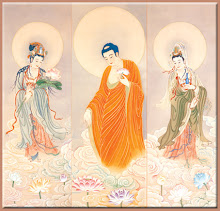
Towards Human Diginity
Sunita was a beggar and a scavenger born into a so called outcast community (pariah). On meeting the Lord Buddha on the Lord's alms-round on day, the humble youth bowed himself before the Master in adoration.
Asking for ordination he is taken to a temple where he soon becomes worthy of the highest respect of the devas and Brahma gods. Therefore the Lord Buddha states in the Dhammapada:-
By one's birth, one is not a pariah,
By one's birth, one is not a Brahmin,
By one's deeds one is a pariah
Equality of Women
It was the Buddha who first gave women her rightful place in society which had ostracised her even to the extent of treating the birth of a girl as an unimportant event.
Knowing that being a woman can also attain the highest level of sainthood, the Buddha permitted the ordination of nuns (Bhikkhunis).
Furthermore, the formation of a Bhikkhuni Sasana (Order of Nuns) by the Lord Buddha was the first in the world.
In the picture on the right, Ven Ananda who had interceded on behalf of the Sakyan ladies, including the Lord Buddha's stepmother, Mahapajapati Gotama.

Human Freedom

Human Freedom
In the time of the Buddha it was common for both men and women to enter services into rich households due to their extreme proverty.
In fact, human slavery was very common at that time, even though it was against the Buddhist teachings.
The state of slavery existed at that time is well shown in left picture by the story of a slave girl Rajjumala who worked for a wicked mistress who treated her without mercy for the slightest fault. Here the Buddha advices both the mistress and servant and teaches them the doctrine and bestows permanent peace for both of them.
In spite of the fact that the study of medicine and surgical science has advanced to a great extent during the Buddha' time, hardly any attention were given to nursing and caring for the sick.
Putigatta Tissa Thera was a monk suffering from skin disease which spread covering his whole body with ulcers.
Lying unattended his condition worsens. The Buddha goes to the dangerous ill monk, bathes him with warm water assisted by Ananda Thera and cleanse his robes.
Having made him comfortable , the Buddha exponds the teachings to him explaining the true nature of the human body. Enlightened by the teachings, Thera becomes an Arahant. The Buddha then addressess the other monks on the ennobling task of caring for the sick.
Accepting the compassionate exhortion of the Master and following his example, the laity started to build wards for sick monks in all large monasteries. Later King Dhammasoka was to build hospitals not only for the public but for animals as well. Hence, the Buddhists should be considered as the first ones to establish hospitals.



No comments:
Post a Comment